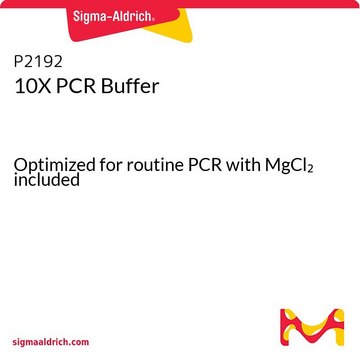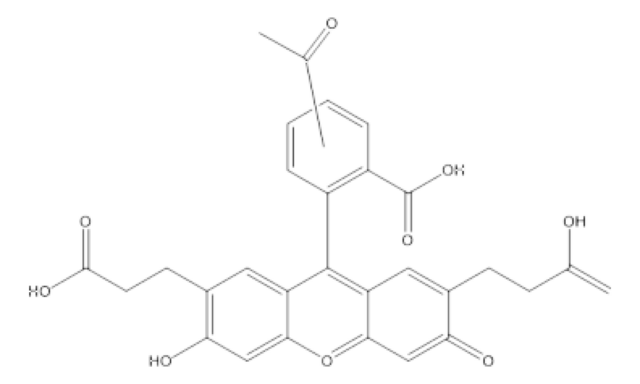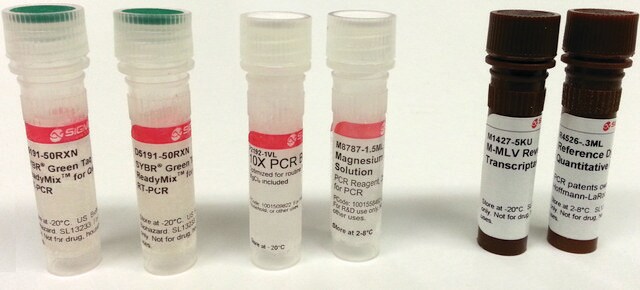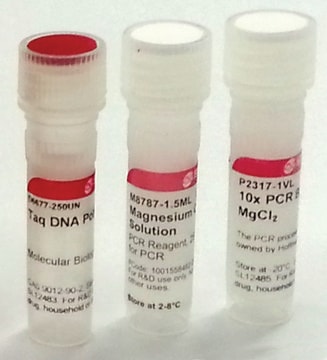MAK150
Fluorometric Intracellular pH Assay Kit
sufficient for 1000 fluorometric tests
Sign Into View Organizational & Contract Pricing
All Photos(2)
About This Item
UNSPSC Code:
12161503
NACRES:
NA.84
Recommended Products
usage
sufficient for 1000 fluorometric tests
detection method
fluorometric
relevant disease(s)
neurological disorders; genitourinary disorders; cancer
storage temp.
−20°C
General description
Intracellular pH changes are implicated in diverse physiological and pathological processes, including cell proliferation, apoptosis, fertilization, malignancy, multidrug resistance, ion transport, lysosomal storage disorders, and Alzheimer′s disease.
This kit can be utilized to measure decreases in intracellular pH in cells treated under various conditions using a simple standard protocol. Alternatively, an Acid-Load procedure can be used to measure the increase of intracellular pH associated with changes in cellular metabolism due to GPCR activation, growth factor activity, or other cellular stimulation. With the Acid-Load procedure ammonium chloride solution is added after the fluorescent pH dye is loaded into cells in a minimum volume. This Acid-Loading step is followed by the addition of agonist in a relatively large volume (~4x) of buffer. The sudden volume change initiates an efflux of ammonia (NH3) from the cells causing a rapid decrease in intracellular pH, and thus a decrease in fluorescence signal. The effect of agonist on the subsequent recovery of intracellular pH is measured by the relative fluorescence signal increase.
This kit can be utilized to measure decreases in intracellular pH in cells treated under various conditions using a simple standard protocol. Alternatively, an Acid-Load procedure can be used to measure the increase of intracellular pH associated with changes in cellular metabolism due to GPCR activation, growth factor activity, or other cellular stimulation. With the Acid-Load procedure ammonium chloride solution is added after the fluorescent pH dye is loaded into cells in a minimum volume. This Acid-Loading step is followed by the addition of agonist in a relatively large volume (~4x) of buffer. The sudden volume change initiates an efflux of ammonia (NH3) from the cells causing a rapid decrease in intracellular pH, and thus a decrease in fluorescence signal. The effect of agonist on the subsequent recovery of intracellular pH is measured by the relative fluorescence signal increase.
Application
Fluorometric Intracellular pH Assay Kit has been used to measure the intracellular pH.
Features and Benefits
Superior alternative to BCECF
Suitability
This kit can be utilized to measure changes in intracellular pH in cells treated under various conditions.
Principle
The Fluorometric Intracellular pH Assay Kit utilizes a proprietary cell-permeable fluorescent indicator, BCFL-AM, for measuring relative intracellular pH changes. BCFL-AM is a superior alternative to the popular ratiometric pH probe, 2′,7′-bis-(2-carboxyethyl)-5(6)-carboxyfluorescein (BCECF). Unlike BCECF, which is a complex and variable mixture of isomers, BCFL-AM is a single isomer species. BCFL-AM has the same spectral responses as BCECF-AM (λex = 490 nm/λem = 535 nm for single measurement or λex = 505 nm/λem = 535 nm and λex = 430 nm/λem = 535 nm for ratio measurement) but enhanced reproducibility. BCFL-AM exhibits pH-dependent dual excitability, pKa ~7.0, and an excitation isosbestic point of 454 nm.
Storage Class
10 - Combustible liquids
wgk_germany
WGK 3
flash_point_f
Not applicable
flash_point_c
Not applicable
Choose from one of the most recent versions:
Certificates of Analysis (COA)
Lot/Batch Number
Don't see the Right Version?
If you require a particular version, you can look up a specific certificate by the Lot or Batch number.
Already Own This Product?
Find documentation for the products that you have recently purchased in the Document Library.
Customers Also Viewed
Selective inhibition of carbonic anhydrase-IX by sulphonamide derivatives induces pH and reactive oxygen species-mediated apoptosis in cervical cancer HeLa cells.
Koyuncu I, et al.
Journal of Enzyme Inhibition and Medicinal Chemistry, 33(1), 1137-1149 (2018)
Shawn C Chafe et al.
Cancer immunology research, 7(7), 1064-1078 (2019-05-16)
Treatment strategies involving immune-checkpoint blockade (ICB) have significantly improved survival for a subset of patients across a broad spectrum of advanced solid cancers. Despite this, considerable room for improving response rates remains. The tumor microenvironment (TME) is a hurdle to
Our team of scientists has experience in all areas of research including Life Science, Material Science, Chemical Synthesis, Chromatography, Analytical and many others.
Contact Technical Service









